
Research Article
Austin J Surg. 2024; 11(5): 1341.
Gender Determines the Characteristics and Treatment of Pediatric Inguinal Hernias: 11-Year Experiences from A Single Center
Kun Wang¹*; Gang Quan Wu¹; Jia Kang Yu²; Jing Cai¹*
¹Dongguan Maternal and Child Health Care Hospital, China
²Department of Pediatric Surgery, Guangzhou Women and Children’s Medical Center, China
*Corresponding author: Jing Cai & Kun Wang, Dongguan Maternal and Child Health Care Hospital, Dongguan 523112, Guangdong, China. Tel:15999862776 Email: caijing258175@126.com; wangwkwang@163.com
Received: November 06, 2024; Accepted: November 28, 2024; Published: December 05, 2024
Abstract
Purposes: The purpose of study was to explore the differential effect of gender on the characteristics and treatment of pediatric inguinal hernias and to evaluate the 11-year experience of our center.
Methods: This study is a retrospective case note review of pediatric inguinal hernias that were treated within an 11-year (2010-2021) period at our center. All patients who received laparoscopic inguinal hernia repair (LIHR) under general anesthesia were included.
Results: A total of 4472 patients were included in this study. The ratio of males to females was 2.52:1. Males had higher rates of both incarcerated and recurrent hernias than females. DLPEC took less time compared to SLPEC. The cost of treating incarcerated hernia was significantly higher than that of nonincarcerated hernia, and the number of hospital days was also higher than that of the nonincarcerated hernia group, with P <0.05. Females and patients under 1 year were more likely to present with an incarcerated hernia.
Conclusions: SLPEC is highly recommended for female patients. For incarcerated hernias and huge hernias, attention should be given to patients under 1 year old because they are more likely to relapse. Surgeons should be cautious about whether to excise ovaries in female ovarian hernia surgery.
Keywords: Gender; Pediatric inguinal hernias; Laparoscopic inguinal hernia repair; Incarcerated hernia
Introduction
Congenital primary inguinal hernia is a common condition among pediatric surgery clinics and is reported to have an incidence ranging from 0.8% to 4.4% [1]. However, in preterm infants, this proportion can be as high as 30% [2], with higher incidence rates among males. In males, the inner ring of the hernia is the vas deferens and the spermatic cord vessels, while in females, the uterine ligament (Figure 1) The gold standard treatment for pediatric IH repair has been high ligation of the hernia sac. Laparoscopic surgery has become the current mainstream method of surgery [3].
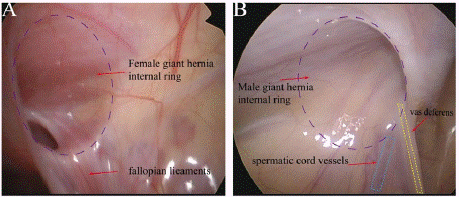
Figure 1: Differences in the hernia ring by sex (A=Female; B=Male).
Although there is much literature regarding pediatric inguinal hernias, large sample size analyses are not common, especially with regard to laparoscopic surgery, and rarely do studies expand on gender differences. At present, there are two main methods of laparoscopic surgery for pediatric inguinal hernia: Single-site laparoscopic percutaneous extraperitoneal closure (SLPEC) or Double-site laparoscopic percutaneous extraperitoneal closure (DLPEC). Open surgery is now rarely performed in our center, except in cases where the incarcerated hernia cannot be reduced over the operating table or when there is necrosis of the incarcerated bowel.
In this study, we describe the different characteristics of pediatric inguinal hernias in a large sample-sized cohort that includes both genders based on our 11-year experience and describe the characteristics and treatments for pediatric ordinary and incarcerated inguinal hernia based on gender report our operative experience.
Methods
Patients
A total of 4472 patients who were admitted to the Affiliated Dongguan Maternal and Child Health Care Hospital, Southern Medical University, and who were diagnosed with inguinal hernia during the span of 2010 to 2021 were included in this retrospective study. All the included patients were =14 years old, and the criteria for diagnosis were as follows: 1) a history of a reversible inguinal mass; and 2) inguinal region ultrasound confirmation and positive physical examination (there was a demonstrable hernia or an incarcerated hernia or incarcerated hernias). Children who had conservative treatment and children with other diseases were excluded. To ensure the consistency of the comparison, we selected the data from the same surgeon for 2 years for the comparisons between SLPEC and DLPEC in terms of the operative time for nonincarcerated hernias. Follow-up was obtained in the outpatient clinic. The retrospective collection of all patients was collected from the patients’ medical records to explore the differential effect of gender on the characteristics and treatment of pediatric inguinal hernias.
Operative Approach
This retrospective study was approved by the Ethics Committee of the Affiliated Dongguan Maternal and Child Health Care Hospital, Southern Medical University. Hernia repair was carried out via high ligation of the hernia sac and was performed as either SLPEC or DLPEC. Because our center has mainly performed laparoscopic surgery, patients who had open surgery were excluded.
Before 2016, all patients received DLPEC. Laparoscopy was performed under general anesthesia using one 5-mm and one 3-mm screw trocar located at the belly button and at the right abdominal wall. The patients were positioned supine on the operative table with the table in a 15 – 20 Trendelenburg position. The average intraabdominal pressure (IAP) was 6–8 mmHg in the patients under 1 year of age, while a mean IAP of 8 – 10 mmHg was adopted for older children. Neither a nasogastric tube or a bladder catheter was positioned during the procedure; however, we emptied the bladder preoperatively to provide a better view of the inguinal region and to eventually identify the concealed hernia and the anatomy of the vas deferens and blood vessels. After general anesthesia was achieved via tracheal intubation, the surgical area was disinfected and covered. A small, curved incision of 5 mm was made into the skin of the lower edge of the umbilicus. First, the abdominal cavity was punctured with a Veress needle to establish a CO2 pneumoperitoneum. After establishing a pneumoperitoneum, a 5-mm screw trocar was used to puncture the abdominal cavity, and a 5-mm 30 laparoscopic camera was placed to identify the cranial part on the affected side. Simultaneously, the contralateral side was assessed for occult or hidden hernia sacs. We placed the operating clamp through the puncture hole of the right abdominal wall to grasp the peritoneal tissue of the inner ring mouth of the clamp to more easily complete the operation. A pointed blade was used to cut a small incision of 1-2 mm in size in the corresponding skin above the cranial part, and a suture line, using a hernia needle, was placed across the vas deferens along the inner ring. Women do not have this structure; therefore, in female patients, the needle could be crossed directly.
With the growing demand of parents for to improvement of cosmetic effects and anesthesia, our hospital introduced SLPEC in 2017. We described a modified laparoscopic herniorrhaphy technique called “Hernia sac ligation by single-incision laparoscopic surgery with a double-line band method” [4]. The biggest difference between SLPEC and DLPEC is the reduction in the number of puncture holes made into the right abdominal wall. The instruments used included a perforated hernia needle, a laparoscopic camera, and a 5-mm screw trocar. The shaft of the scope is inside the peritoneal cavity and is used to complete the knot. At least one auxiliary incision was eliminated, and the appearance of the wound was improved.
Statistical Analysis
All the data were analyzed using SPSS for Windows version 17.0. Data are presented as the mean ± standard deviation. Categorical variables are presented as frequencies and percentages. The chi-square test and t test were used to establish significance among two and single categorical data groups, respectively, and P<0.05 was considered statistically significant.
Results
This study included 3201 male patients and 1271 female patients (the boy to girl ratio was 2.52:1). The age range at the time of surgery was 16 days to 14 years, and the average age was 2.68 years. There were a total of 2255 unilateral hernias (50.42%) and 2217 bilateral hernias (49.58%), with a corresponding ratio of 1.02:1. The incidence of Unilateral hernia in the male and female patients was 41.41% and 9.01%, respectively, with a corresponding ratio of 4.60:1. The incidence of bilateral hernia in the male and female patients was 40.94% and 8.63%, respectively, with a corresponding ratio of 4.73:1. The incidence of incarcerated and recurrent hernias was 4.87% and 0.78%, respectively. For the incarcerated hernias, the proportions of the male and female patients were 4.25% and 0.63%, respectively, with a corresponding ratio of 6.79:1. In the recurrent hernia group, the male and female patients accounted for 0.72% and 0.07%, respectively, with a corresponding ratio of 10.67:1. Demographics of the patients are described in Table 1.
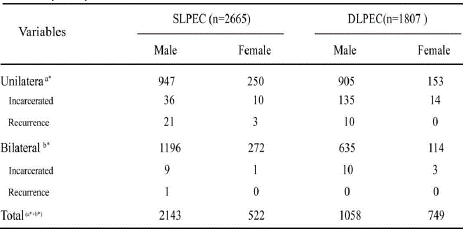
Table 1: Demographics of patients with inguinal hernia established during
hernia repair operaion.
The included 4,472 patients underwent laparoscopic hernia repair surgeries. Of the 4,472 surgeries, 2665 (59.6%) were SLPEC, and 1807 (40.4%) were DLPEC. There was an obvious increase in laparoscopic hernia repair surgeries over the years, with only 80 surgeries in 2010 and 721 surgeries in 2021 (Figure 2). After 2017, there was rapid growth, with the amount of laparoscopic surgery approximately doubling, and it was from this year that we used a modified laparoscopic technique called hernia sac ligation by singleincision laparoscopic surgery with a double-line band method.
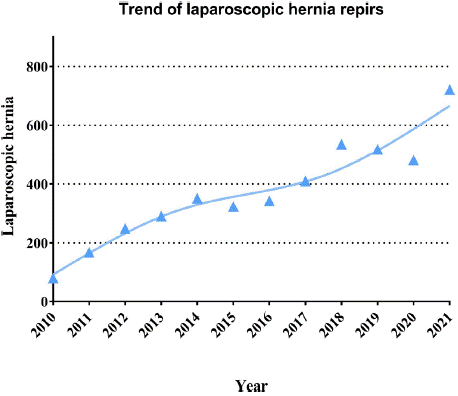
Figure 2:
As the number of laparoscopic surgeries increases year by year, due to the popularization of medical knowledge, the incidence of incarcerated hernia has shown a downward trend, and many children receive timely and effective treatment in the early stage of the disease to avoid the occurrence of incarceration. In our center, the recurrent hernia rate has been controlled at a low-level owing to the improved surgical techniques, and recurrence mostly occurs male patients and is a unilateral recurrence (Figure 3).
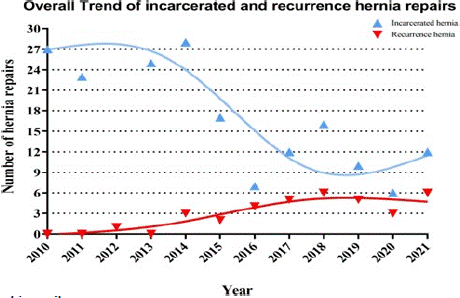
Figure 3:
To contrast the differences in operation time and gender between the SLPEC and DLPEC groups and to ensure consistency, we compared the number of patients with the same doctor for 2 years in the total data. It can be found that boys are still more commonly affected than girls, with P <0.05, which is statistically significant. There were no significant differences in the surgical time of the oblique inguinal hernias, either unilateral or bilateral, in females, with P> 0.05. The surgical time spent in a single bilateral oblique inguinal hernia in males was less in the DLPEC group than in the SLPEC group, with P <0,0.05. By comparing the total operation time, the DLPEC will take less time to complete the operation compared to the SLPEC (Table 2).
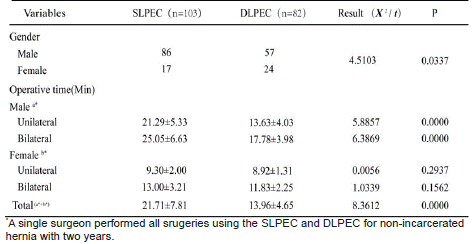
Table 2: Comparisons between SLPEC and DLPEC for non incarcerated
Furthermore, by comparing the incarcerated and nonincarcerated hernia data, we found that the lesion was significantly more common in males than in females, that males were more common at all ages, and that the incidence of incarcerated hernia was significantly reduced in females after 1 year of age. In terms of hospitalization and surgical consumables, the cost of incarcerated hernia was significantly higher than that of nonincarcerated hernia, and the hospital days were also higher than that of the nonincarcerated hernia group, with P <0.05 (Table 3).
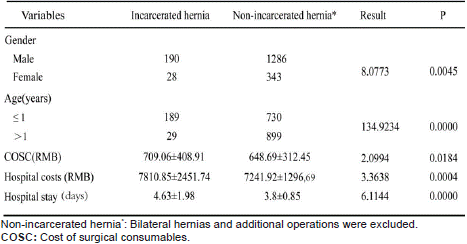
Table 3: Comparisons between incarcerated hernia and Non-incarcerated
hernia*.
Most of the children with recurrent hernia were giant hernias in the previous operation, and the incidence was obvious in men than in women, and it was positively correlated with the diameter of the inner ring.Although DLPEC has a lower recurrence rate compared with SLPEC, SLPEC still has a great advantage in beautifying wounds, especially in girls (Table 4).
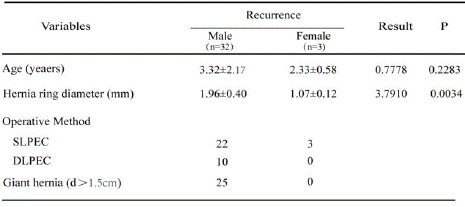
Table 4: The differences of recurrent hernias by age and gender.
Discussion
Inguinal hernia is a common surgical disease with an estimated incidence of 0.8-4.4%. There are various surgical treatments available for inguinal hernias. Worldwide, laparoscopic surgery is one of the most common surgical procedures performed on children [5-7]. In our center, hernia repair comprises up to 40% of all operations.In clinical, the hernia that we encounter can be roughly divided into four types (Figure 4 & Figure 5). Common type hernia (d<1cm), Recurrent hernia (Common internal ring scar hyperplasia), Incarcerated hernias (incarcerated bowel or ovary), Giant hernia (d=1.5cm). From Table 4, we found that most of the recurrent hernias were boys, and most of the children with recurrent hernias were giant hernias in the previous surgery, and the probability of recurrence in girls was significantly lower than that in boys. In our center, we often use SLPEC for recurrent hernia, pull the umbilical wrinkle to the inner ring to complete the double suture, and reduce the risk of recurrence. Although from Table 4, SLPEC is more likely to develop recurrent hernia than DLPES. Surgical minimalism in pediatric surgery consists of single-site laparoscopic surgery. Since 2017, our center has performed singlehole laparoscopic surgery to meet the needs of parents for minimally invasive surgery. Since 2017, the number of laparoscopic surgeries in our center has been on the rise. Boys have a higher incidence and recurrence rate of oblique inguinal hernias than girls. Reviewing our 11-year experience of 4472 patients between 2010 and 2021, we have summarized the characteristics and treatment results for pediatric ordinary and incarcerated inguinal hernias based on sex and provide recommendations accordingly. To our knowledge, we are the largest pediatric surgical treatment center in Dongguan and have the largest number of pediatric inguinal hernia participants.

Figure 4: Type of female hernia (A=Common type hernia; B=Recurrent
hernia; C=Incarcerated hernias; D=Giant hernia).

Figure 5: Type of male hernia (A=Common type hernia; B=Recurrent
hernia; C=Incarcerated hernias; D=Giant hernia).
Based on the results, we concluded that 1) the incidence of unilateral hernias in male and female patients was 4.60:1; 2) the incidence of bilateral hernias in male and female patients was 4.73:1; 3) the incidence of incarcerated and recurrent hernias was 6.79:1; and 4) in recurrent hernias, the ratio of male to female patients was 10.67:1. The above ratio was higher than the reported 2.5:1 [8]. However, this is largely consistent with the ratio of 4.8:1 described in Wang, K et al [9]. The occurrence of oblique inguinal hernias has an obvious sex difference, which is associated with the testicular descent in boys, and the postoperative recurrence rate is much higher in boys than that in girls [10]. In our impression, boys will be naughtier.
The gold standard treatment for pediatric IH repair has been high ligation of the hernia sac. Over the past two decades, laparoscopic herniorrhaphy has increased in popularity [11]. The choice between OIHR and LIHR has always been a controversial issue [6,12-13]. There is still no clear consensus regarding which technique is superior in children who need to undergo inguinal hernia repair: open or laparoscopic [14-16]. In our center, in the treatment of oblique inguinal hernias in children, OIHR has not been commonly used unless the intraoperative incarcerated hernia is associated with intestinal necrosis. Therefore, we have more experience sharing our experience with LIHR. LIHR has become a mainstream pediatric hernia technique in various regions. Single-hole laparoscopic surgery has gradually developed due to the improvement of surgical instruments and technology. The best benefit of laparoscopic hernia repair is the opportunity for intraoperative inspection of the contralateral groin. In the data from our center, the recurrence rate after laparoscopic surgery was controlled at 0.78%. This rate is slightly lower than the 1% recurrence rate reported in other reports. For recurrent hernias, we usually still use laparoscopic surgery after 3-6 months. There are no three relapses in the current follow-up. The postoperative recurrence rate in boys was much higher than that in girls (10.67:1). There are two reasons: the preoperative hernia is a huge hernia and boys themselves will be naughtier than girls and will have more premature and strenuous exercise after surgery, which results in suture rupture in the surgical area, resulting in recurrence. By comparing the total operation time, DLPEC will take less time to complete the operation compared to SLPEC. However, there were no significant differences in the surgical time of the female oblique inguinal hernias, either unilateral or bilateral, with P> 0.05, and there was less time spent on the female patients than in the male patients. Therefore, we believe that laparoscopic surgery, especially single-port laparoscopic surgery, is more suitable for girls, and clinically, we found that even with ovarian incarceration, laparoscopic surgery is still applicable. In our center, for all incarcerated ovarian hernias in girls, no ovaries were removed, with or without ovarian necrosis. We suggest that this maximizes the function of the incarcerated ovary. Instead of removing the ovaries, even if atrophy of the affected ovary is found during the follow-up process, we still believe that the incarcerated ovary retains part of its secretory function. Of course, this requires the evaluation of long-term follow-up in the future.
Based on the abovementioned findings, single-port laparoscopic surgery is more suitable for girls' hernias. In terms of safety and aesthetics, double-port laparoscopy has more advantages. It should be emphasized that the surgeon’s learning curve is substantial with LIHR [17]. For a beginner, laparoscopic surgery for inguinal hernias in girls also helps the surgeon to master its technical points in a short time, which is conducive to shortening the learning curve. The spermatic cord and vas deferens are anatomical structures unique to males. Therefore, the difficulty of laparoscopic surgery is increased in males, especially for single-hole laparoscopic surgery, which requires surgeons to have more clinical experience.
Our study has some limitations. First, this was a retrospective study, and boys are more prone to oblique inguinal hernias than girls due to their anatomy. Second, we did not carry out an extensive postoperative long-term follow-up and did not carry out an assessment of ovarian function after the treatment of incarcerated hernia in females. In addition, infantile oblique inguinal hernia and premature birth and low body weight were correlated, but our study data did not include the data of gestational age and birth weight of children, so comparative analysis of embryonic development cannot be conducted.
Conclusions
No definitive conclusions regarding the superiority of SLPEC and DLPEC can yet be drawn from the available data. We concluded that SLPEC should be considered for male patients, especially when dealing with a unilateral hernia or a complete inguinal hernia. The existing anesthetic techniques and laparoscopic techniques have allowed for the creation of sufficient conditions for surgery. However, if an intraoperative vas anatomical abnormality is found or if the hernia needle passes through it, it is difficult to choose between DLPEC or open surgery decisively. For the four types of pediatric hernia we have seen clinically: We believe that a common hernia (d<1cm) or the recurrent hernia will select the SLPEC if possible, If the inner ring diameter is greater than 1cm, or a giant hernia, DLPEC is a better option. Our experience is to suture the umbilical wrinkle to the inner ring simultaneously to strengthen the strength of the inner ring and reduce the recurrence rate. DLPEC was used for the most part of the incarcerated hernias. For female patients, SLP EC was preferred. In particular, regarding the occurrence of ovarian insertion, pediatric surgeons should be cautious when performing ovarian resection. The experience of our center is that we did not remove the ovary, and even if ovarian necrosis occurred, the return to the abdominal cavity did not affect the healing of the child.
Author Statements
Acknowledgements
We are indebted to Jing Cai contributions on the data analysis, Xiao Wei Li, Jia Kang Yu and Gang Quan Wu given a great help in the surgical operation and device design.
Authors Contributions
Kun Wang, Jing Cai, performed the data analyses and wrote the manuscript; Gang Quan Wu performed the surgeries and contributed significantly to analysis and manuscript preparation; Jia Kang Yu, Gang Quan Wu, helped perform the analysis with constructive discussions. All authors reviewed the manuscript.
Declaration of Conflicting Interests
Kun Wang, Jing Cai, Jia Kang Yu, Gang Quan Wu have no conflicts of interest or financial ties to disclose.
Funding
The author(s) disclosed receipt of the following financial support for the research, authorship, and/or publication of this article: The General Project of Social Science and Technology Development in Dongguan City of China (Nos.20221800900392).
References
- Lao OB, Fitzgibbons RJ Jr, Cusick RA. Pediatric inguinal hernias, hydroceles, and undescended testicles. Surg Clin North Am. 2012; 92: 487–504.
- Kumar VH, Clive J, Rosenkrantz TS, Bourque MD, Hussain N. Inguinal hernia in preterm infants (< or = 32-week gestation). Pediatr Surg Int. 2002; 18: 147–52.
- Matthew P, Shaughnessy, Nathan L Maassel, Nicholas Yung, Daniel G Solomon, Robert A Cowles. Laparoscopy is increasingly used for pediatric inguinal hernia repair. Journal of Pediatric Surgery. 2021; 56: 2016-2021.
- Wang K, Cai J, Lu YC, Li XW, Zhai GM, He WB, et al. A faster and simpler operation method for laparoscopic inguinal hernia repair in children. Journal of Laparoendoscopic & Advanced Surgical Techniques. 2020; 30: 706-11.
- Esposito Ciro, Maria Escolino, Giuseppe Cortese, Gianfranco Aprea, Francesco Turrà, Alessandra Farina, et al. Twenty-year experience with laparoscopic inguinal hernia repair in infants and children: considerations and results on 1833 hernia repairs. Surgical endoscopy. 2017; 31: 1461-1468.
- Dreuning, Kelly, Sanne Maat, Jos Twisk, Ernest van Heurn, and Joep Derikx. Laparoscopic versus open pediatric inguinal hernia repair: state-ofthe- art comparison and future perspectives from a meta-analysis. Surgical endoscopy. 2019; 33: 3177-3191.
- Zhu LL, Xu WJ, Liu JB, Huang X, Lv ZB. Comparison of laparoscopic hernia repair and open herniotomy in children: a retrospective cohort study. Hernia. 2017; 21: 417–23.
- Alshammari D, Sica M, Talon I, Kauffmann I, Moog R, Becmeur F, et al. Our laparoscopic surgical technique and experience in treating pediatric inguinal hernia over the past decade. Journal of Indian Association of Pediatric Surgeons. 2020; 25: 28-33.
- Wang Kai, Sarah Siyin Tan, Yue Xiao, Zengmeng Wang, Chunhui Peng, Wenbo Pang, et al. Characteristics and treatments for pediatric ordinary and incarcerated inguinal hernia based on gender: 12-year experiences from a single center. BMC surgery. 2021; 21: 1-7.
- Wang KS, Committee on Fetus and Newborn, American Academy of Pediatrics; Section on Surgery, American Academy of Pediatrics. Assessment and management of inguinal hernia in infants. Pediatrics. 2012; 130: 768– 773.
- Bruns NE, Shah MA, Dorsey AN, Ponsky TA, Soldes OS. Pediatric surgery - a changing field: national trends in pediatric surgical practice. J Pediatr Surg. 2016; 51: 1034–8.
- Esposito C, St Peter SD, Escolino M, Juang D, Settimi A, Holcomb GW 3rd. Laparoscopic versus open inguinal hernia repair in pediatric patients: a systematic review. J Laparoendosc Adv Surg Tech A. 2014; 24: 811–18.
- Juang D, Fraser JD, Holcomb GW 3rd. The laparoscopic approach for repair of indirect inguinal hernias in infants and children. Transl Pediatr. 2016; 5: 222–6.
- Kantor N, Travis N, Wayne C, Nasr A. Laparoscopic versus open inguinal hernia repair in children: which is the true gold-standard? A systematic review and meta-analysis. Pediatr Surg Int. 2019; 35: 1013-1026.
- Van Batavia JP, Tong C, Chu DI, Kawal T, Srinivasan AK. Laparoscopic inguinal hernia repair by modified peritoneal leaflet closure: Description and initial results in children. J Pediatr Urol. 2018; 14: 272.e1–e272.e6.
- Shalaby R, Ismail M, Shehata S, Gamaan I, Yehya A, Elsayaad I, et al. Shalaby technique for efficient single incision laparoscopic pediatric inguinal hernia repair. Journal of Pediatric Surgery. 2015; 50: 1995-2000.
- Shaughnessy R, Matthew P, Nathan L Maassel, Nicholas Yung, Daniel G Solomon, Robert Cowles. Laparoscopy is increasingly used for pediatric inguinal hernia repair. Journal of Pediatric Surgery. 2015; 56: 2016-2021.